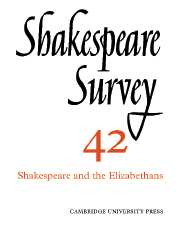Book contents
- Frontmatter
- ‘Jack hath not Jill’: Failed Courtship in Lyly and Shakespeare
- Truth and Art in History Plays
- Chronicles and Mythmaking in Shakespeare’s Joan of Arc
- King John and Embarrassing Women
- Golding’s Ovid, Shakespeare’s ‘Small Latin’, and the Real Object of Mockery in ‘Pyramus and Thisbe’
- Ovid and the Sonnets; or, did Shakespeare Feel the Anxiety of Influence?
- The Play of Sir Thomas More and Some Contemporary Events
- ‘Nobody’s Perfect’: Actors’ Memories and Shakespeare’s Plays of the 1590s
- The Boyhood of Shakespeare’s Heroines
- Shakespeare’s ‘Brawl Ridiculous’
- Shakespeare’s Handwriting
- Shakespeare Performances in England, 1987–8
- Professional Shakespeare Productions in the British Isles, January-December 1987
- The Year's Contributions to Shakespearian Study 1 Critical Studies
- 2 Shakespeare’s Life, Times, and Stage
- 3 Editions and Textual Studies
- Books Received
- Index
Chronicles and Mythmaking in Shakespeare’s Joan of Arc
Published online by Cambridge University Press: 28 March 2007
- Frontmatter
- ‘Jack hath not Jill’: Failed Courtship in Lyly and Shakespeare
- Truth and Art in History Plays
- Chronicles and Mythmaking in Shakespeare’s Joan of Arc
- King John and Embarrassing Women
- Golding’s Ovid, Shakespeare’s ‘Small Latin’, and the Real Object of Mockery in ‘Pyramus and Thisbe’
- Ovid and the Sonnets; or, did Shakespeare Feel the Anxiety of Influence?
- The Play of Sir Thomas More and Some Contemporary Events
- ‘Nobody’s Perfect’: Actors’ Memories and Shakespeare’s Plays of the 1590s
- The Boyhood of Shakespeare’s Heroines
- Shakespeare’s ‘Brawl Ridiculous’
- Shakespeare’s Handwriting
- Shakespeare Performances in England, 1987–8
- Professional Shakespeare Productions in the British Isles, January-December 1987
- The Year's Contributions to Shakespearian Study 1 Critical Studies
- 2 Shakespeare’s Life, Times, and Stage
- 3 Editions and Textual Studies
- Books Received
- Index
Summary
Like many characters of historical fiction, Joan of Arc in Shakespeare's First Part of Henry the Sixth is largely a creation of other texts, and some would have the dramatist (perhaps in his late twenties) powerless to consolidate her amid the passions and contradictions that beset these texts. Noting the contrasts between Joan at the beginning and end of the play, Shaw supposed that Shakespeare
having begun by an attempt to make Joan a beautiful and romantic figure, was told by his scandalized company that English patriotism would never stand a sympathetic representation of a French conqueror of English troops, and that unless he at once introduced all the old charges against Joan of being a sorceress and a harlot, and assumed her to be guilty of all of them, his play could not be produced.
Nowadays scholars usually concede that Shakespeare wrote this uneven play, though a noteworthy case has been made for returning it to the composite authorship that was widely accepted, if on tenuous grounds, fifty years ago. 'Shakespeare's Joan', then - and inverted commas are implicit in everything that follows - refers to a literary character who is perhaps not the property of any author, who came to Shakespeare already 'created' by a century of chronicle writers, and whose devising, there is a good chance, may not have been Shakespeare's at all. For that matter, Shakespeare's reputed source, Raphael Holinshed, probably did not write the account of Joan usually attributed to him.
- Type
- Chapter
- Information
- Shakespeare Survey , pp. 25 - 36Publisher: Cambridge University PressPrint publication year: 1990
- 1
- Cited by

